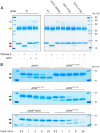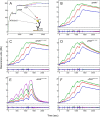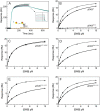Did evolution create a flexible ligand-binding cavity in the urokinase receptor through deletion of a plesiotypic disulfide bond?
- PMID: 30894413
- PMCID: PMC6509485
- DOI: 10.1074/jbc.RA119.007847
Did evolution create a flexible ligand-binding cavity in the urokinase receptor through deletion of a plesiotypic disulfide bond?
Abstract
The urokinase receptor (uPAR) is a founding member of a small protein family with multiple Ly6/uPAR (LU) domains. The motif defining these LU domains contains five plesiotypic disulfide bonds stabilizing its prototypical three-fingered fold having three protruding loops. Notwithstanding the detailed knowledge on structure-function relationships in uPAR, one puzzling enigma remains unexplored. Why does the first LU domain in uPAR (DI) lack one of its consensus disulfide bonds, when the absence of this particular disulfide bond impairs the correct folding of other single LU domain-containing proteins? Here, using a variety of contemporary biophysical methods, we found that reintroducing the two missing half-cystines in uPAR DI caused the spontaneous formation of the corresponding consensus 7-8 LU domain disulfide bond. Importantly, constraints due to this cross-link impaired (i) the binding of uPAR to its primary ligand urokinase and (ii) the flexible interdomain assembly of the three LU domains in uPAR. We conclude that the evolutionary deletion of this particular disulfide bond in uPAR DI may have enabled the assembly of a high-affinity urokinase-binding cavity involving all three LU domains in uPAR. Of note, an analogous neofunctionalization occurred in snake venom α-neurotoxins upon loss of another pair of the plesiotypic LU domain half-cystines. In summary, elimination of the 7-8 consensus disulfide bond in the first LU domain of uPAR did have significant functional and structural consequences.
Keywords: LU domain; disulfide; fibrinolysis; hydrogen exchange mass spectrometry; plasminogen regulation; protein evolution; receptor structure-function; small-angle X-ray scattering (SAXS); surface plasmon resonance (SPR); urokinase receptor.
© 2019 Leth et al.
Conflict of interest statement
The authors declare that they have no conflicts of interest with the contents of this article.
Figures








Similar articles
-
Evolution and Medical Significance of LU Domain-Containing Proteins.Int J Mol Sci. 2019 Jun 5;20(11):2760. doi: 10.3390/ijms20112760. Int J Mol Sci. 2019. PMID: 31195646 Free PMC article. Review.
-
Stabilizing a flexible interdomain hinge region harboring the SMB binding site drives uPAR into its closed conformation.J Mol Biol. 2015 Mar 27;427(6 Pt B):1389-1403. doi: 10.1016/j.jmb.2015.01.022. Epub 2015 Feb 7. J Mol Biol. 2015. PMID: 25659907
-
Crystal Structures of Human C4.4A Reveal the Unique Association of Ly6/uPAR/α-neurotoxin Domain.Int J Biol Sci. 2020 Jan 30;16(6):981-993. doi: 10.7150/ijbs.39919. eCollection 2020. Int J Biol Sci. 2020. PMID: 32140067 Free PMC article.
-
Structure and ligand interactions of the urokinase receptor (uPAR).Front Biosci. 2008 May 1;13:5441-61. doi: 10.2741/3092. Front Biosci. 2008. PMID: 18508598
-
Structure-function relationships in the receptor for urokinase-type plasminogen activator. Comparison to other members of the Ly-6 family and snake venom alpha-neurotoxins.FEBS Lett. 1994 Aug 1;349(2):163-8. doi: 10.1016/0014-5793(94)00674-1. FEBS Lett. 1994. PMID: 8050560 Review.
Cited by
-
Targeting the Urokinase-Type Plasminogen Activator Receptor (uPAR) in Human Diseases With a View to Non-invasive Imaging and Therapeutic Intervention.Front Cell Dev Biol. 2021 Aug 20;9:732015. doi: 10.3389/fcell.2021.732015. eCollection 2021. Front Cell Dev Biol. 2021. PMID: 34490277 Free PMC article. Review.
-
Unfolding of monomeric lipoprotein lipase by ANGPTL4: Insight into the regulation of plasma triglyceride metabolism.Proc Natl Acad Sci U S A. 2020 Feb 25;117(8):4337-4346. doi: 10.1073/pnas.1920202117. Epub 2020 Feb 7. Proc Natl Acad Sci U S A. 2020. PMID: 32034094 Free PMC article.
-
Carboxyl-terminal sequences in APOA5 are important for suppressing ANGPTL3/8 activity.Proc Natl Acad Sci U S A. 2024 Apr 23;121(17):e2322332121. doi: 10.1073/pnas.2322332121. Epub 2024 Apr 16. Proc Natl Acad Sci U S A. 2024. PMID: 38625948 Free PMC article.
-
The intrinsic instability of the hydrolase domain of lipoprotein lipase facilitates its inactivation by ANGPTL4-catalyzed unfolding.Proc Natl Acad Sci U S A. 2021 Mar 23;118(12):e2026650118. doi: 10.1073/pnas.2026650118. Proc Natl Acad Sci U S A. 2021. PMID: 33723082 Free PMC article.
-
The Urokinase Receptor (uPAR) as a "Trojan Horse" in Targeted Cancer Therapy: Challenges and Opportunities.Cancers (Basel). 2021 Oct 27;13(21):5376. doi: 10.3390/cancers13215376. Cancers (Basel). 2021. PMID: 34771541 Free PMC article. Review.
References
-
- Ploug M., Rønne E., Behrendt N., Jensen A. L., Blasi F., and Danø K. (1991) Cellular receptor for urokinase plasminogen activator: carboxyl-terminal processing and membrane anchoring by glycosylphosphatidylinositol. J. Biol. Chem. 266, 1926–1933 - PubMed
-
- Kjaergaard M., Hansen L. V., Jacobsen B., Gardsvoll H., and Ploug M. (2008) Structure and ligand interactions of the urokinase receptor (uPAR). Front. Biosci. 13, 5441–5461 - PubMed
-
- Connolly B. M., Choi E. Y., Gårdsvoll H., Bey A. L., Currie B. M., Chavakis T., Liu S., Molinolo A., Ploug M., Leppla S. H., and Bugge T. H. (2010) Selective abrogation of the uPA-uPAR interaction in vivo reveals a novel role in suppression of fibrin-associated inflammation. Blood 116, 1593–1603 10.1182/blood-2010-03-276642 - DOI - PMC - PubMed
-
- Gårdsvoll H., Jacobsen B., Kriegbaum M. C., Behrendt N., Engelholm L., Østergaard S., and Ploug M. (2011) Conformational regulation of urokinase receptor function: impact of receptor occupancy and epitope-mapped monoclonal antibodies on lamellipodia induction. J. Biol. Chem. 286, 33544–33556 10.1074/jbc.M111.220087 - DOI - PMC - PubMed
MeSH terms
Substances
Associated data
- Actions
- Actions
- Actions
- Actions
- Actions
LinkOut - more resources
Full Text Sources
Miscellaneous

